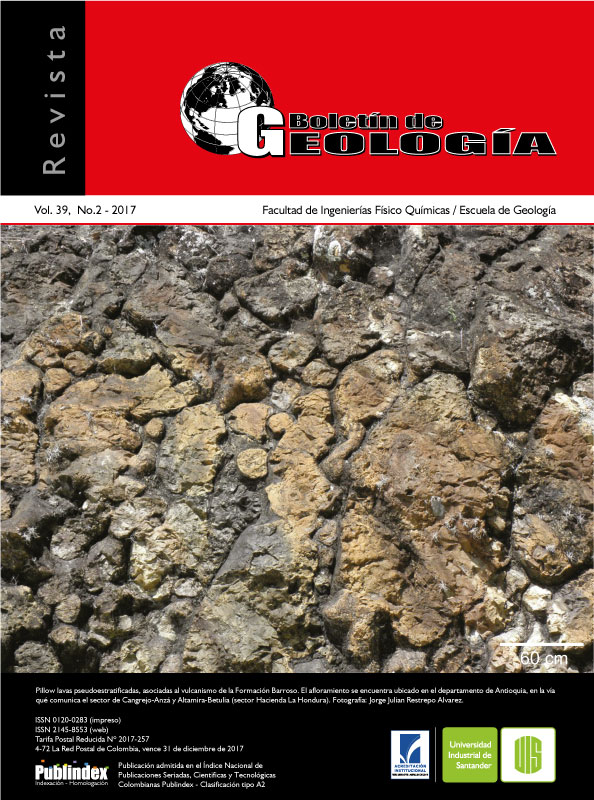PHYSICAL VULNERABILITY OF BUILDING ROOFS OF NORMAL OCCUPANCY USE FACING ASHFALL IN THE GALERAS VOLCANO INFLUENCE ZONE
Published 2017-06-14
Keywords
- Vulnerability,
- building roofs,
- ashfall,
- Galeras volcano
How to Cite
Altmetrics
Abstract
The main focus of this research is a method for assessing the physical vulnerability of building roofs due to overloading of ashfall by eruptions of Galeras volcano. In order to know the possible affectation of roofs and buildings, damage relationships are established for types of roofs based on their typology, distances between supports and state. The vulnerability assessment allows estimating the likely degree of damage of the roof and building. The methodology starts from characterizing the hazard to establish the intensity pattern to analyze the resistance of the exposed element, which for ash, is the load transferred by a thickness accumulated on the roof. Additionally, an inventory of exposed elements was made, defining type of roofs, materials, geometric configuration and state, as well as of the building, which allow to categorize in roof types. Then the resistance is analyzed in order to determine the maximum stress that leads to failure, evaluating also, the impact on the entire building. The probability of damage is estimated using a cumulative distribution function, taking into account the variance of the boundary stress due to factors such as material heterogeneities, element dimensions, constructive effects or ash load distribution according to the wind path, roof style, as well as the moisture present in the ash. The vulnerability assessment in Galeras zone, shows that although light and moderate roofs are more vulnerable to ash loads, the effect of overall damage to the building is less, as opposed to heavy roofs and slabs. This study formulates considerations in the design of building roofs located in adjacent areas to active volcanoes, which could be the basis for the creation of a standard for design and construction of overload ash-resistant roofs.
Downloads
References
- ATC-13. 1985. Earthquake damage evaluation for California. Applied Technology Council, Report No. 13. Redwood City, USA, 492p.
- Calvache, M. 1990. Geology and volcanology of the recent evolution of Galeras volcano, Colombia. MSc. Thesis, Louisiana State University, USA. 171p.
- CORPOSSO. 2009. Evaluación de la vulnerabilidad física y funcional a fenómenos volcánicos, en el área de influencia del Volcán Galeras. Convenio de Cooperación N° 1005-08-12-07 entre el Fondo nacional de Calamidades y la Corporación OSSO. Pasto, 535p.
- Díaz-Granados, M. 1994. Elementos probabilísticos del riesgo. Curso de educación continuada, evaluación y mitigación de riesgos naturales. Universidad de Los Andes. Bogotá, 17p.
- Dorado, L. 2013. Evaluación de vulnerabilidad de edificaciones ante caída de ceniza por eventos eruptivos del volcán Galeras en la cabecera urbana del municipio de Consacá – Departamento de Nariño. Tesis de Maestría, Desarrollo Sustentable con énfasis en Prevención y Atención de Desastres. Universidad del Valle. Cali, 88p.
- ERN-AL. 2009. Vulnerabilidad de edificaciones e infraestructura. Informe Técnico ERN-CAPRA-T1-5. Evaluación de Riesgos Naturales América Latina- ERN-AL.
- INGEOMINAS. 1997. Memoria del mapa de amenaza volcánica del Galeras. Tercera versión. Publicación Especial de INGEOMINAS. Bogotá. 38p.
- INGEOMINAS. 1998. Evaluación de la vulnerabilidad de cubiertas de viviendas expuestas a la caída de ceniza en la zona de influencia del volcán Galeras. INGEOMINAS. Pasto. 96p.
- López, O. 1997. Evaluación de la resistencia estructural de las cubiertas de las edificaciones ubicadas en la zona de influencia del volcán Galeras. INGEOMINAS. Pasto, 102p.
- Marks, L. 1982. Manual del Ingeniero Mecánico. México D.F.: Ed. Baumeister Theodore. McGraw Hill.
- Miranda, E. 1999. Approximate seismic lateral deformation demands in multistory buildings. Journal of Structural Engineering, 125(4): 417-425.
- Ordaz, M. 2000. Metodología para la evaluación del riesgo sísmico enfocada a la gerencia de seguros por terremoto. Universidad Nacional Autónoma de México. México DF.
- PADT-REFORT. 1984. Manual de diseño para maderas del Grupo Andino. Proyectos Andinos de Desarrollo Tecnológico en el área de los Recursos Forestales. Junta del Acuerdo de Cartagena. Lima, Perú, 485p.
- SGC-UNGRD. 2012. Análisis probabilista de riesgo volcánico para el volcán Galeras - Colombia. Servicio Geológico Colombiano SGC y Unidad Nacional para la Gestión del Riesgo de Desastres - UNGRD. Technical Assistance Project (TAP) con fondos del Banco Mundial y el Global Facility for Disaster Reduction and Recovery (GFDRR). Asistencia Técnica del consorcio ERN-AL. Bogotá, 72p.
- Spence, R., Pomonis, A., Baxter, P., Coburn, A., White, M., and Dayrit, M. 1996. Building damage caused by the Mount Pinatubo eruption of June 15, 1991. In: Newhall, C.G., and Punongbayan, R. (Eds.). Fire and Mud: Eruptions and Lahars of Mount Pinatubo, Philippines. Philippine Institute of Volcanology and Seismology, Quezon City.
- Spence, R., Kelman, I., Baxter, P., Zuccaro, G., and Petrazzuoli, S. 2005. Residential building and occupant vulnerability to tephra fall. Natural Hazards and Earth System Sciences, 5: 477-494.
- Tilling, R. 1993. Volcanic hazards. World Organization of Volcano Observatories (WOVO - IAVCEI). Santa Fe, New Mexico, 125p.
- Torres, R. 2001. Vulnerabilidad estructural de edificaciones de uso general ante eventos eruptivos del volcán Galeras en su zona de influencia. INGEOMINAS. Pasto, 122p.
- Torres, R., and Cárdenas, R. 2006. Vulnerability of normal occupation houses before the ash fall of the Galeras volcano. Fourth Conference Cities on Volcanoes, International Association of Volcanology and Chemistry of the Earth’s Interior - IAVCEI. Quito, pp. 141
- Torres, R., Ponce, P., y Gómez, D. 2012. Estimación de funciones de vulnerabilidad ante erupciones volcánicas. Servicio Geológico Colombiano SGC. Technical Assistance Project (TAP) con fondos del Banco Mundial y el Global Facility for Disaster Reduction and Recovery (GFDRR). Asistencia Técnica del consorcio ERN-AL. Pasto, 13p.
- UNDRO. 1991. UN Office of the Disaster Relief Coordinator. Mitigating natural disasters: Phenomena, effects and options: A manual for policy makers and planners. United Nations Publication. Nueva York, 164 p.
- Zuccaro, G., Cacace, F., Spence, R., and Baxter, P. 2008. Impact of explosive eruption scenarios at Vesuvius. Journal of Volcanology and Geothermal Research, 178(3): 416-453.
